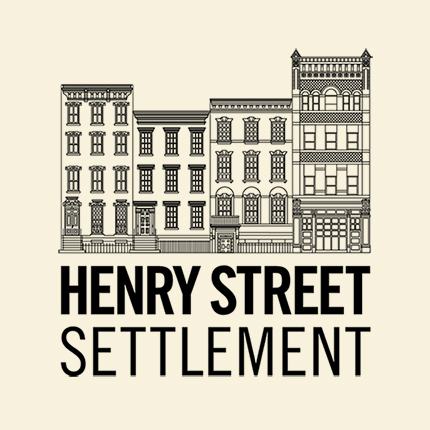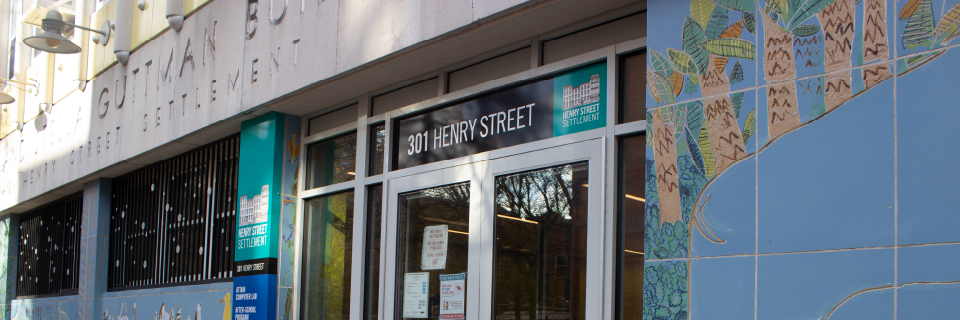Henry Street Settlement opens doors of opportunity for Lower East Side residents and other New Yorkers through social service, arts, and health care programs.
The two adjoining structures known as 301 Henry Street were constructed separately and at different periods, but were eventually combined to share interior halls and mechanical systems. Together these buildings are known as the Helen Hall Youth Center. They house Henry Street’s Youth Services Division.
Pete’s House, the earlier of the two structures, originally held a pair of row houses that were altered over the years for multiple housing. By 1920, the two original buildings were functioning as a small synagogue. The Settlement acquired the property, and with extensive alterations converted it into a youth center. The project, funded by Edith and Herbert Lehman, was named Pete’s House in memory of their son Peter, who had worked as a volunteer youth leader at the Settlement. During World War II he was an officer in the U.S. Air Force, and was killed in England in 1944.
Designed by architects DeYoung, Moscowitz and Rosenberg, construction was completed on the building in 1948. The simplified Colonial Revival façade shows the architects’ desire to reflect the style of the Settlement’s historic original buildings just yards away on Henry Street. The four-story with basement building has a six bay façade with six over six double hung windows, a dark red brick façade, raised decorative beaded mortar joints, and a limestone belt course above the first-story windows. The sills, lintels and rooftop parapet coping are also smoothly tooled limestone. Decorative ironwork on the front façade consists of elliptical wrought iron window railings on the second level that are repeated in the roof level coping railing. The granite foundation is followed vertically upward by a four-foot brick foundation that culminates with a horizontal molded brick course set into the plane of the front façade of the building. A pair of raised panel oak doors are recessed into the façade with a granite stoop below and horizontal transom light above. The Pete’s House name is carved into the limestone lintel above.
At the opening day ceremony, more than 1,500 people attended the outdoor dedication in front of Pete’s House. At the ribbon cutting, Herbert Lehman — who in 1932 succeeded Franklin Delano Roosevelt as Governor of New York — spoke of his son Peter, “He would, in his kindly heart, wish that Pete’s House may be a center where many of our young people of all faiths and races and national origins can meet in friendship and goodwill.” Pete’s House still serves this mission for the Lower East Side community today.
The Charles and Stella Guttman Building, which adjoins Pete’s House, was funded by Charles Guttman, who as a child lived in a house on the same site. Growing up in the neighborhood he participated in many of the programs offered by Henry Street, and his fondest memories were of the summer sleep away camp the Settlement offered to neighborhood children.
Charles Guttman commissioned the same architects who designed Pete’s House: DeYoung, Moscowitz and Rosenberg. They combined the functions of the buildings and planned the Guttman building using a unique and youth oriented design. The four-story with basement structure has white glazed brick, blue and yellow terracotta spandrel panels and limestone columns and copings clad across the upper front facade. The original renderings of the building called for a glass curtain wall between the columns across the first level at the street level. Instead, the architects used blue tiles showing animal and jungle fantasies designed by the children from the Settlement’s art programs. The prominent limestone band above the first level is carved with the benefactor’s names. The interior lobby retains the original multi-color glass one-inch wall tile, which was very popular during the period. The addition upgraded the youth center with an elevator, HVAC system, gymnasium, classrooms, and library that more than doubled the Settlement’s capacity to serve the youth in the community.
At the building’s dedication in 1964, Charles Guttman said, “Henry Street Settlement took me and a lot of Irish and Italian kids and sent us off to the country. You can’t explain what a thrill it was. I’ll never forget it, and there’s no way I can really pay them back. I never knew what a cow was. This contribution doesn’t even the score, but at least it serves to mark an experience that helped open a poor boy’s eyes to the possibilities of life in America.” Today, the programs offered at the Charles and Stella Guttman Building continue to open children’s eyes to the great possibilities that lay before them.

